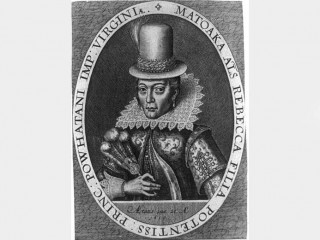
Pocahontas biography
Date of birth : -
Date of death : 1617-03-21
Birthplace : Virginia, U.S.
Nationality : American
Category : Famous Figures
Last modified : 2010-05-25
Credited as : Symbol of goodwill, John Rolfe, Virginia colony
Venerated as a symbol for goodwill between England and Native Americans, Pocahontas was the daughter of a tribal chief in present-day Virginia. She would eventually marry an Englishman before traveling to England to represent her people. With her upstanding status, British and Native Americans of the area would enjoy prosperity and peace together for nearly a decade.
Even though her real name was Matoaka and her Christian baptized name was Rebecca, she is most often remembered by her nickname Pocahontas, which means “playful one” in Algonquian. Because she was the daughter of a powerful tribal chief of the Powhatan people and all the Algonquian tribes, she was raised in the elite setting of her tribe. Additionally, however, as a young girl, she would play near the British forts where many of the soldiers noticed her beauty and intelligence.
In one story that is still debated, it is said that Pocahontas saved the life of one captain named John Smith. The captain had been captured by Powhatan warriors and would have been killed had she not stepped in and demanded his release. Through this diplomatic measure, both John Smith and all of Jamestown saw that peace could be reached through mutual understanding. Despite the new-forged relationship between the Native Americans and the British, it was never a completely peaceful one. The capture of Pocahontas as a hostage to Captain Samuel Argall of the ship The Treasurer meant that the Indians and the English would have to come to common grounds so that the Powhatan princess would be spared.
While in captivity, one captain named Thomas Dale looked upon her not as a Native American enemy, but as an intelligent girl with a bright future helping to lead her people. During her time in Jamestown, Pocahontas was baptized. However, Pocahontas would not fall in love with Dale. It was John Rolfe, also from Jamestown, who asked for her hand in marriage. Even though Pocahontas may have already had another husband in her tribe, both the Powhatan and English people agreed to the marriage that would unite the two sides.
In Jamestown in 1614, Pocahontas was married to Rolfe and would thereafter travel to Britain to gain investment dollars from British royalty. She, along with her husband, brother, and several other Indian girls traveled to London and were accepted as royalty. With the investments secured, they were ready to sail back to Virginia, but Pocahontas developed a case of smallpox that took her life. Her young son, Thomas Rolfe, remained in England for his education and later returned to Virginia as a businessman and started his own family. Her story was made into a Walt Disney film entitled Pocahontas in 1995.
















